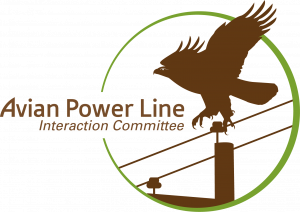Frequently Asked Questions
Question: Do large birds perch on electrical wires?
Answer: Yes! Large birds, from pelicans to raptors, can perch on electrical wires, or conductors. (Pictured: Brown Pelican-left, Red-tailed Hawk-right)

.jpg)

Question: How can birds perch on a wire and not be electrocuted?
Answer: For electrocution to occur, a bird (or animal) must complete an electrical circuit by simultaneously touching two energized parts, or an energized part and a grounded part. Small birds such as blackbirds and starlings (pictured right) are often seen perching on energized wires (or conductors) but, these birds are too small to make simultaneous contact between conductors.
Question: What is a streamer and how can it affect power reliability?
Answer: Streamers are long "streams" of excrement from large birds such as herons or large raptors, that are often expelled as a bird takes off from a perch. Streamers can impact reliability in several ways. If a streamer contacts an energized conductor, the electrical current may travel through the streamer back to the bird or pole. This may cause a bird electrocution, power outage, and/or line trip. More commonly, streamers may impact power reliability through the build-up of excrement on insulators. This contamination can compromise the integrity of an insulator, resulting in power outages or line trips. Excrement contamination is greatest in areas where large birds frequently use structures for nesting, roosting, or perching. (Pictured: Red-tailed Hawk releasing streamer-left, cormorant nests above conductors and insulators may pose contamination problems-right)
.jpg)
Question: What should I do if I find a dead bird below a power pole?
Answer: Leave the bird on site and do not touch or remove the carcass. If you have a camera, take pictures of the bird, pole, and any pole identification markers. Record the location as accurately as possible. Report the information to the U.S. Fish and Wildlife Service and/or your state wildlife resource agency, and the power company.
Question: Is it possible to prevent birds from perching on poles?
Answer: There are no devices that are completely effective in preventing birds from perching on poles. If a bird wants to perch on a structure, they often find a way! Devices installed to prevent perching may actually provide a substrate to secure nest material, and, in some cases, may increase electrocution risk. Prather and Messmer (2010) tested several types of perch discouragers and found no difference in perching on poles with or without discouragers (J. Wildlife Management 74:796-800). (Pictured: Crested Caracara perched on pole with perch discouragers)
Question: My utility is interested in developing an APP. Where do we start?
Answer: Developing a new APP can be an overwhelming task. To start, it helps to identify your company’s key avian issues, e.g., is your utility a co-op with distribution lines in agricultural areas that attract raptors, or is your utility a transmission company that is building new lines in potential bird habitat? By identifying the key biological issues that your company may face (e.g., electrocutions, collisions, nests, construction activity) and your type of operations (distribution, transmission, small or large service territory), you can begin prioritizing what you will need in an APP. APLIC resources, including the APP Guidelines {link} and short courses {link} can help you develop an APP. The APP Guidelines are intended to provide utilities with resources and examples that can be tailored to a company’s specific needs. When developing an APP, you should contact your local USFWS office and state wildlife resource agency for information on bird concentration areas, regulations, and permits. Likewise, other utilities with implemented APPs can provide guidance based on their experience and lessons learned. While an APP may not initially be comprehensive, it should start with components that are a higher priority to your utility, and should refine and build on these over time.
Question: How do I find out what permits my utility needs to salvage carcasses or manage nests of protected bird species?
Answer: Contact the U.S. Fish and Wildlife Service Migratory Bird Permit Office in your region (http://www.fws.gov/permits/) to identify federal permit requirements. You should also contact your state wildlife resource agency to identify state permit requirements.
Question: What is "avian-safe" or "raptor-safe"?
Answer: An "avian-safe" power pole is a configuration designed to minimize bird electrocution risk by providing sufficient separation between phases and between phases and grounds to accomodate the wrist-to-wrist or head-to-foot distance of a bird. If such separation cannot be provided, exposed parts are covered to reduce electrocution risk. The term "avian-safe" has recently replaced the term "raptor-safe", as bird protection is designed to benefit a variety of birds, not just raptors.
Would you like to submit a question? If so, please contact the APLIC Executive Committee at aplic@aplic.org.
.


